The First Autonomous Cars

Although the very first developments in the area of self-driving cars occurred in the 1920s and 1930s, it wasn’t until the end of the 1980s that we saw the first driverless ride.
This trailblazer was the Navlab 1, a Chevrolet van developed by Carnegie Mellon University. It was equipped with countless computers, a Cray supercomputer, cameras and sensors as well as a global positioning receiver. The Navlab 1 was built in 1986, but it was a few more years before it was fully functional. However, this vehicle only featured semi-autonomous control, limited to the accelerator and steering wheel. The Navlab 1 was only able to travel a short distance at a maximum speed of 32 km/h.
Read also
Carnegie Mellon University then developed the Navlab 2, this time using a U.S. Army HMMWV vehicle. More advanced computers helped the Navlab 2 reach a maximum speed of 110 km/h, and it featured certain off-road capabilities—it was a military vehicle, after all. Like the Navlab 1, it relied on satellite positioning to control accelerations and turns, but it was not able to monitor its perimeter like the driverless cars that are currently being developed today. To date, the university has produced 11 prototypes of driverless vehicles.
German automaker Mercedes-Benz, with the help of Bundeswehr University Munich, set up the Eureka Prometheus Project. The first vehicles resulting from their research were the VaMP and the VITA-2, which travelled more than 1,000 kilometres on a multi-lane highway in Paris, in traffic, at speeds reaching 130 km/h. In 1995, the team struck again with an autonomous Mercedes-Benz S-Class, which travelled 1,000 km from Munich to Copenhagen, hitting 175 km/h on the Autobahn and achieving 158 km without human input.








